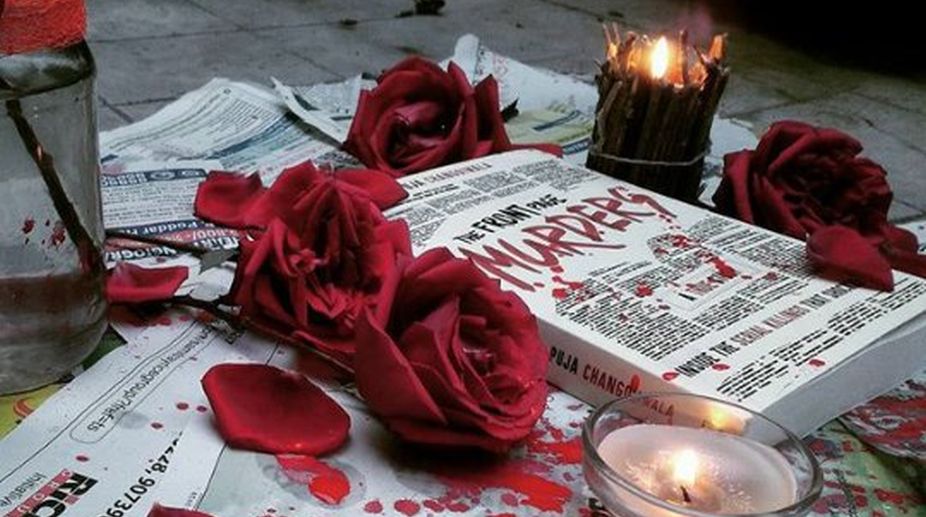The publishing industry calls this genre "True Crime". We have not seen much of it from Delhi, despite the city being awash with media outlets. Perhaps this is because Delhi is a city where politics matter above all, and crime is of secondary importance. In 2015, there was Aarushi by journalist Avirook Sen but this look at the Talwar case came rather late in the day, as the murder dates back to 2008. He writes after the fact, since he was never a crime reporter, and he presents the whole case like a clever lawyer, in a way that exonerates the parents, which raises questions about the writer's motives.
Mumbai has done much better in this genre. Mafia Queens of Mumbai by investigative reporter Hussain S Zaidi came out in 2011 and received rave reviews. Zaidi followed it in 2012 with the book Dongri to Dubai: Six Decades of the Mumbai Mafia. This is a history of the Mumbai underworld: Dawood Ibrahim, Haji Mastan, Karim Lala, Chhota Rajan and Abu Salem. Of course, the Hindi film industry has given us many movies based on these characters, so they are always alive and kicking in the popular imagination.
There has been a long gap but the wait has been worth it, with Puja Changoiwala's The Front Page Murders: Inside the Serial Killings That Shocked India now in our hands. The book could have benefited from a better title, as it gives no clue the author she is talking about a particular serial killer, Vijay Palande. She is a much more classy writer than Sen and Zaidi, able to give an insider's account of the experience of crime reporting. The worlds of policing and media both suffer from a crisis of credibility but she pushes aside all the cynicism and makes one believe that systems work: One, that the police goes about investigations with serious intent and without the corruption we hear about all the time; two, that for media organisations, professional challenges like getting exclusive stories are still serious business. This is what makes the book so endearing, and so good for gifting to the younger generation. Incidentally, if you are looking for such a gift, another book that makes you believe in the police force is Veerappan: Chasing the Brigand by former STF chief K Vijay Kumar.
Changoiwala, who worked for the Hindustan Times in Mumbai, takes the reader along in the mad story chase, giving a good idea of the physical acrobatics as well as the mental calisthenics that enable a crime reporter to get ahead of the pack when a story makes the front pages of a newspaper. The life-saving inputs from sources, the hours-long wait for police officers to brief the press, the adrenalin rush, the despair at missing out on an angle ~ all this is conveyed in breathless prose punctuated by humour. The case of killer Vijay Palande is told from start to finish with enough suspense and twists to make it unputdownable.
A few secrets are also revealed. Sample this: As the men neared us, Shinde's strong build and spotless clothes prompted a journalist to ask, "Dummy hai kya? The cops blushed in response and the journalist laughed. We had all heard of cases where policemen, when unable to find the real culprit, asked random people, sometimes one of their own men, to stand veiled before the press, posing as the accused for pictures…"
Like the Indrani Mukherjee case, this one too unfurls bit by bit, as reporters and police chase one bit of evidence after another. In this case too, the bodies were dumped along the highway in the Western Ghats. The brutality of the stabbings and the deliberate intent of the killer have a chilling effect as the narrative progresses. A lot of elements are typical of Mumbai: celebrities, models, Bollywood aspirants, deranged dreamers and relentless pursuit of big money.
Most of the story is told via dialogues between people, as direct speech, avoiding big intimidating blocks of text. This makes it an easy read. The reader also feels reassured by the author's research, which reveals that the West may have psychopathic killers, who enjoy mutilating and eviscerating (as shown most memorably in Silence of the Lambs) but only a handful of Indians have been mentally unstable: Auto Shankar, the Nithari killers and Darbara Singh aka Baby Killer of Punjab. Their primary motive is to rob, and the killing is what she calls "collateral damage".
Unusually for a book, and more typical of magazines, the pages are dotted with pithy sayings on the practice of journalism. These aphorisms are relevant to the situation the author is describing, as in "Journalists do not have patience. They have deadlines". Or more insightfully: "Journalism is turning people's fears into words, pictures and videos".
Rather unfairly, the book ends with an indictment of the system and of public interest in such stories. She writes, "It is our voyeuristic love of their antics…that makes them covet notoriety. It is our judiciary and the long years that undertrials spend languishing in prisons that makes them seek revenge. It is our police who treat them like scoundrels, beat their bodies and their soul, that make them even more coldblooded."
If society at large is responsible for criminal behaviour, why are murderers such a small part of our vast population? And if media coverage is feeding voyeurism, then there is no need for a book to retell the sensational story of a serial killer. Reporters should go on to tell more such stories without their collective conscience pricking. And tell them eloquently, as Puja Changoiwala has done.











